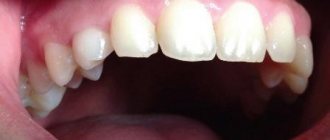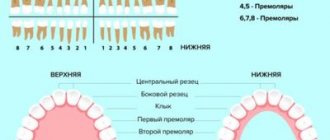Some people use the services of a dentist to change their appearance. The procedure for extending fangs is popular. Adding fangs to healthy teeth allows you to create a vampire look. Before extensions, you should familiarize yourself with the contraindications and possible consequences. You should first weigh all the pros and cons.
Why canine extensions are performed, indications
Any adult has four fangs in his mouth - two at the top and two at the bottom. Visually, they are practically no different from other teeth. Some young people, fans of mysticism and the aesthetics of vampirism, turn to the dentist for fang extensions. The procedure allows them to bring their image closer to that of a vampire.
There are also certain medical indications for canine extensions. Only a dentist can prescribe such extensions. The technique is safe and can be performed by almost anyone. There are several ways to lengthen teeth, in most cases the direct method is used. The length of the extended tooth should not exceed 4 mm. It should be taken into account that an elongated tooth in the mouth can create discomfort and there is a risk of injury to the mucous membrane.
Indications for the procedure:
- therapy - extensions are carried out in case of chips or damage to the crown;
- aesthetic goal - whether there is a need to change the size or shape of the tooth;
- orthopedics - extension is carried out when a tooth is completely destroyed and needs to be restored.
The choice of augmentation technique depends on the indications.
Technique
The operation of cutting down teeth to straighten them takes place in several steps:
- Preliminary preparation: the dentist assesses the dental condition. Then determines whether there is a need to file hard tissue. At the end, a conclusion is made about whether the patient has contraindications to the operation.
- Finding areas that have problem areas. To do this, a carbon copy, liquid spray or wax strip is taken, and the dentist identifies irregularities and abnormal heights of some teeth. Those areas that need filing are stained more heavily.
- Anesthesia and filing. The process is carried out differently in each case. Each patient has an individual dental arrangement. This is also due to the fact that there are various goals that need to be achieved. Also important is the individual shape of the teeth, which need to be ground down to straighten them.
For example, processing chewing molars. The dentist carefully files down the top layer of enamel from the surface of the tubercles. To file the central incisors, the doctor uses cutting movements in various directions.
There are cases when it is necessary to make a preventive model for diagnosis, which is based on casts of the jaws. The samples received by the dentist are thoroughly reviewed and filing options are assessed. The standard tools in the operation are carborundum cutters or diamond burs.
Advantages and disadvantages
Fang extensions have certain advantages and disadvantages. Advantages of the technique:
- aesthetics;
- durability;
- the possibility of full restoration - restored fangs become natural;
- no load on neighboring teeth;
- the ability to choose a shade;
- painlessness - there are no discomfort during canine extensions;
- the opportunity to change the image.
Flaws:
- high price - often due to the need for additional procedures;
- the possibility of redistributing the load during chewing, which will lead to damage to other teeth;
- risk of injury to the oral cavity due to a canine broken during chewing;
- unpredictability of expectations from the procedure - some patients are pleased with their fangs for a short period of time;
- impossibility of tooth extension in the presence of a partially damaged root.
Filing before prosthetics
Before installing crowns or veneers, the enamel must be ground down. This procedure is significantly different from cosmetic filing and is called tooth preparation. If, in order to restore aesthetics, a small layer of enamel is removed, then before installing veneers, the treatment area is much larger.
Veneers and crowns are volumetric products. If you leave your teeth untouched, excess volume will appear. In addition, the design will not be able to fit harmoniously into the dentition. The natural shape of teeth is not ideal, so it is almost impossible to make crowns that fit them with maximum precision. That is why, with the help of grinding, excess volume is removed, bulges are eliminated, and the correct shape is given.
Veneers are installed with minor grinding, as they are thin. In the case of crowns, complete grinding is necessary on all sides. Dissection can be painful, so it is usually performed under anesthesia. When grinding, all tissue affected by caries is removed to eliminate the risk of secondary infection.
How much enamel will be removed during grinding? Don't worry about this. If you visit a really good specialist, only an acceptable layer of tissue will be removed. The first time after filing, increased sensitivity of the teeth may occur. Soon this phenomenon will disappear.
Now you can imagine how many indications there are for filing teeth. In the photo you have already seen what a cosmetic technique is. Grinding teeth for veneers looks completely different. The final video will introduce you to the veneer preparation procedure.
Contraindications
Fang extensions are not recommended in the following cases:
- severe abrasion of tooth enamel;
- signs of periodontitis;
- defects in the root region;
- malocclusion - shifting the load during chewing can lead to excess pressure on individual elements;
- failure to comply with oral hygiene rules;
- allergic reactions to materials used in extensions.
Ignoring contraindications can lead to serious damage to the chewing teeth. Before the procedure, it is recommended to eliminate all of the listed defects.
Who is indicated and contraindicated
Teeth grinding is a dental procedure that is aimed at correcting visible defects: uneven edges, enamel damage, and malocclusion. In addition, it is used during operations, using it as a preparatory stage.
Photos before and after teeth filing:
Before going for dental filing, consultation with a specialist is required. Whether it is possible to file the front teeth depends on the presence of contraindications, which include:
- bruxism (teeth grinding during sleep, occurs regularly at night);
- increased sensitivity of enamel;
- accelerated destruction of tooth enamel;
- the patient's exposure to bad habits (gnawing nuts with his mouth, nibbling the ends of pens and pencils);
- increased risk of injury to incisors or canines (especially in boxers and wrestlers).
If the specialist did everything correctly, the teeth will be filed without difficulty. There can be only one nuance - the enhanced sensuality of the enamel. But it lasts for a few days and then goes away. The existing correction options are calculated by the doctor you contacted. Dental grinding is necessary when other correction options, in the opinion of a specialist, will not help.
Preparation
Extension of fangs requires preliminary preparation. Preparatory procedures are divided into preliminary (optional) and immediate (mandatory).
Preparation may include the following procedures:
- Professional cleaning of tartar, plaque and dirt. The procedure allows you to set the actual shade of enamel for choosing a material. The specialist must take into account the different colors of the base and edges of the tooth.
- Treatment of caries is a mandatory procedure.
- Taking impressions allows you to determine the best tooth shape.
- Canine preparation is carried out before applying the composite material. The procedure ensures tight fixation of the composite on the tissue. The part being built up will receive additional thickness.
- Grinding of hard tissues - allows you to give the tooth a natural shape. Care is taken during the procedure to avoid damage to the internal layers and eliminate pigmented areas of dentin.
Technique
The operation of cutting down teeth to straighten them takes place in several steps:
- Preliminary preparation: the dentist assesses the dental condition. Then determines whether there is a need to file hard tissue. At the end, a conclusion is made about whether the patient has contraindications to the operation.
- Finding areas that have problem areas. To do this, a carbon copy, liquid spray or wax strip is taken, and the dentist identifies irregularities and abnormal heights of some teeth. Those areas that need filing are stained more heavily.
- Anesthesia and filing. The process is carried out differently in each case. Each patient has an individual dental arrangement. This is also due to the fact that there are various goals that need to be achieved. Also important is the individual shape of the teeth, which need to be ground down to straighten them.
For example, processing chewing molars. The dentist carefully files down the top layer of enamel from the surface of the tubercles. To file the central incisors, the doctor uses cutting movements in various directions.
There are cases when it is necessary to make a preventive model for diagnosis, which is based on casts of the jaws. The samples received by the dentist are thoroughly reviewed and filing options are assessed. The standard tools in the operation are carborundum cutters or diamond burs.
Extension methods
There are several ways to grow fangs in dentistry. The choice depends on the condition of the teeth, clinical picture, and patient preferences.
Direct method
The direct method of extension is the most gentle. All manipulations are carried out directly in the patient’s oral cavity. The composite material is applied to the teeth in layers. The final stage is grinding and polishing. The selection of parameters is carried out taking into account the characteristics of the dentofacial apparatus. The procedure is similar to nail extensions. The duration of the procedure does not exceed 2 hours. It is worth noting that fangs grown with reflective material do not darken over time and are compatible with living tissues. Stages of extension:
- turning of hard tissues - the procedure allows you to create the shape of a fang;
- surface insulation - latex fabric with a hole for the fang will help prevent moisture from entering;
- enamel conditioning - increases the adhesion strength of composites to the tooth;
- application of adhesive systems - ensures a strong connection of composite materials with dentin.
- layer-by-layer application of the composite - it all depends on the desired shape and degree of tooth destruction;
- grinding and polishing;
- highlighting - the procedure accelerates the hardening process of the composite.
When using composite materials for restoration, you should be aware of certain features of the technique. The degree of porosity may exceed the porosity of tooth enamel. This requires two precautions. First of all, for several days after the procedure, you should avoid eating foods and drinks with coloring components in their composition. The second mandatory condition is professional hygiene twice a year. Thorough polishing will help preserve the original shade of the fangs.
Veneers
Veneers are ultra-thin overlays that are attached to the teeth from the front. Their thickness is 0.5 mm. Overlays allow you to correct darkened enamel, defects, chips, diastemas, cracks. After their installation, the teeth take on the desired shape. The procedure is carried out after grinding down the enamel layer, thereby ensuring strong adhesion. Veneers are either composite or laboratory-made. The service life of the plates reaches 101-5 years. Stages:
- grinding down the enamel - a specialist applies special grooves to fix the onlays on the teeth;
- preparation of casts;
- installation of temporary plastic overlays;
- installation of permanent veneers using cement.
Composite veneers are created in one session in the dental chair. The material is applied in layers. The second method is less durable; such veneers require regular polishing.
Lumineers
Lumineers are ultra-thin overlays. Their installation does not require preliminary preparation of the tooth. Dental porcelain with minerals is used in the manufacture of plates. Overlays allow you to hide color defects and blemishes. And it can be removed, no need to grind off the enamel. The installation procedure only takes a couple of procedures. At the first visit, the patient is examined, the dentist listens to the patient’s wishes and offers options. The impression taken is sent to the laboratory. Next time, the doctor installs ready-made lumineers on a previously cleaned tooth.
Stump tab
Fang augmentation is also carried out in case of a damaged tooth. When restoring a tooth that has broken away from the base, it is recommended to use a core inlay. Metal alloys, zirconium dioxide, ceramics, and plastic are used in manufacturing. Ceramics and zirconium have excellent characteristics. They look great, are durable, and do not destroy surrounding tissue. When making core inlays, individual parameters are taken into account; everything depends on the shape of the tooth being restored. The dimensions should not exceed the size of the teeth; a composite is applied on top or a crown is fixed. The recovery procedure takes up to a month. Stages of installing the stump tab:
- removal of damaged tissue, expansion of channels;
- taking an impression for the inlay;
- installation of the structure using dental glue;
- creating a layout for the crown;
- fitting, choice of color for crowns;
- coating application;
- fixation of the finished crown.
Artificial crowns
Prosthetics is the most radical method. The patient should be warned that there is no reversal after the crowns are installed. The method is labor-intensive; extensive tissue preparation is first carried out. Artificial crowns are made taking into account the characteristics of the dental system. Crowns can be installed on ground teeth, pins, stump inlays. Stages of making fangs:
- At the initial stage, an impression is made. Based on this, a specialist works in laboratory conditions to create a fang. Gypsum is used as a test material.
- Trying on, adjusting the layout, sending the cast for revision if necessary.
- Installation of a temporary structure for 2 weeks.
- Choice of material - the artificial tooth is made of zirconium dioxide, metal ceramics. The first option is in great demand due to its strength, wear resistance, and aesthetics.
- Making a new crown and fixing it with cement.
Realistic acrylic fangs
Staging and automation of sound [sh] at home
It’s worth noting right away that making such vampire teeth will require some money and time. For manufacturing you will need the following materials:
- Alginate, which can be purchased at dental supply stores or specialty art stores.
- Mouth guard or paper cup.
- Plastic resin that will be needed for sealing. It can be replaced with other similar material.
- Clay for modeling, as well as a small tool for shaping.
- Acrylic for nails.
- Vaseline or Vaseline oil.
Progress:
- First of all, you need to cut off the top of the plastic cup using scissors. The rest of the cup with the bottom should be slightly higher in height than your upper jaw. Using scissors, cut one side to create a hole that will fit into your mouth. If you have a real mouth guard, you can skip this step.
- Next, you need to mix the alginate mass and lubricate the mouth guard with it. You need to work very quickly, since you are using alginate. After a few hours, as a rule, such a mixture begins to disintegrate and crack.
- Press the upper teeth onto the alginate. After 3 minutes, you can remove the mouth guard by sharply pulling it down. This way you will get an impression of your teeth. Do not wear the mouth guard too high on your teeth. It is necessary to remove only when the alginate has hardened. To find out the exact time of readiness, you can place a small piece of alginate on your finger and wait for it to harden.
- It is necessary to mix a two-component plastic polymer or any other injection molding material. The polymer should not be too toxic after drying.
- The polymer mixture must be poured into the dental impression. Pour slowly, preventing the formation of bubbles. In just a few minutes the mixture will become hot and turn white. You don't need to touch it with your hands. Wait for the mixture to dry and cool before removing it from the cast.
- From the resulting cast it is necessary to make vampire teeth. To do this, apply clay to the cast where the fangs will be. Using some sharp object, you need to give the teeth the desired shape.
- After this, the resulting impression must be soaked in soapy water for 10 minutes. This action will prevent the alginate from sticking to the clay.
- Next, you need to make another impression using alginate. This time you need to use a plastic resin cast with the fangs attached instead of your own teeth.
- The clay fangs must be removed and the cast should be smeared with Vaseline. This will make it easier to remove the acrylic fangs when they are ready.
- You need to mix acrylic nail paint to form a paste. Pour the resulting acrylic paste into the hole for the teeth on the cast.
- After this, you need to press the sample of teeth onto the impression, and then wait for the acrylic to harden. The impression should be carefully removed when the acrylic is almost hardened but still sticky.
- Finally, you need to separate the acrylic fangs and place them on your teeth. If vampire fangs do not stick well to the teeth, they can be glued using base or dental wax.
Care
Immediately after growing the fangs, the dentist applies a special varnish to them. It provides protection. The layer helps prevent damage to the material from external factors (dyes, high temperatures). Dentists recommend growing fangs at the age of no earlier than 16-18 years.
Extended teeth require certain care. Compliance with hygiene rules and dentist recommendations will help avoid caries and other problems.
Recommendations:
- twice daily brushing of teeth;
- use of non-abrasive paste, soft and medium brush;
- refusal of coffee, smoking, strong brewed tea;
- regular preventive dental examinations, timely response to pathological symptoms.
Five ways to make vampire fangs at home
in category: About teeth
What party or Halloween can take place without the presence of a vampire. The black coat and pale look have faded into the background in modern cinema, so you can match the look in regular jeans. But what you really can’t do without is the main attribute of any vampire, his fangs.
Prices for this element of a fancy dress costume are often unreasonably high, so you should think about making them yourself. There are many different ways to make teeth or jaws like a real vampire, the five most popular materials for making them are:
- Paper;
- Plastic fork;
- Artificial nails;
- Cotton wool;
- Clay or plasticine.
It is folded like origami, quickly and easily, but you should not choose a white color of paper, since the natural color of the teeth will stand out with yellowness against its background. The downside of this method is not durability; the paper jaw will crumple and become saturated with saliva in a couple of minutes.
Therefore, it should only be used for a spectacular appearance, in the midst of a party.
How to quickly grow fangs from a plastic fork at home? To do this, use scissors to cut out the two middle tines of a regular white or beige plastic fork.
Next, cut off the handle to the beginning of the bend, but just above the line of the teeth. Wash the resulting form thoroughly under the tap.
We attach the convex side to the upper jaw using dental wax or nail glue.
You can also cut off the two outer tines of a plastic fork and attach them with thin strips of tape.
- Plastic fork;
- Knife or scissors;
- Dental wax, nail glue or tape.
How to easily make vampire teeth or fangs from artificial nails with your own hands? To grow such fangs at home, you will need to purchase a set of artificial nails from a cosmetic store. It is preferable to choose beige or milky nails. Depending on the size of your own teeth, you need to select two nails from the set.
Using scissors and a nail file, give them a cone-shaped, pointed shape. Next, try it on in front of a mirror and adjust the length if necessary. It is better to trim and file the nail over a spread newspaper, so as not to litter the room
Nail glue must be used with caution, as in large quantities it can damage the enamel
It is best to use dental or base wax for fastening.
As a replacement for nails, you can cut plastic pads from scrap material. A white jar of vitamins or a plastic cup are perfect for growing fangs at home, like a real vampire. To do this, you need to cut out two pads from plastic and attach them using one of the above methods.
- A set of artificial nails (white plastic as a replacement);
- Scissors;
- Nail file;
- Dental wax or nail glue.
Fangs made of cotton wool
How to make fangs from cotton swabs or swabs with your own hands in a couple of minutes, at home? Growing fangs from cotton wool will not take much time and effort. It is necessary to form two cotton cones, elongated in shape, and carefully attach them to the teeth.
- Cotton swab or cotton swab;
- Scissors;
- Dental wax or glue.
How to make fangs from polymer clay or hardening plasticine with your own hands? If you build up teeth sculpted from plasticine or clay, then even those made at home will look no worse than those bought in a store. Environmentally friendly plasticine can be purchased in any children's goods department. Unlike clay, it hardens on its own within twenty minutes and does not require heating in an oven.
White plasticine should be mixed with a small amount of yellow to obtain a more natural color. From the resulting mass, you need to sculpt two fangs of an elongated, flattened shape, approximately twice as long as your own. It is better to attach it with dental wax or nail glue.
- Clay or plasticine;
- Modeling kit;
- Dental wax or glue.
Possible consequences
Even following the rules does not guarantee the absence of negative consequences in the future. The cost of canine extensions is another barrier.
Possible negative consequences:
- Caries - develops as a result of injury to the enamel. Violations of the integrity of the dental covering threaten caries. Instead of vampire fangs, black carious spots may form, which will ruin all expectations.
- Increased tooth sensitivity to temperature and foods with different tastes. Forced filing of enamel always leads to increased sensitivity. Discomfortable sensations can occur even when inhaling cold street air.
- Discomfort while eating. The canines are designed for biting and crushing food, then it goes to the molars for further grinding. Artificially lengthened canines may lose functionality. Poor quality chewed food can lead to the development of gastrointestinal diseases.
- Risk of chipping. Extended fangs lose their hardness; they can break even when chewing a small cracker. When a large amount of enamel is removed, the likelihood of complete tooth destruction remains.
- Discomfortable sensations in the oral cavity. Long fangs pose a danger to the lips and gums, and problems may arise when closing the jaws. The inability to close the mouth leads to increased salivation, which has little to do with the image of a predatory vampire.
Vampire teeth made from a plastic fork
If the tips are too long, cut them off. Now use a nail file to give your nails a pointed tooth shape. Try on your teeth in front of a mirror to make sure the shape suits you. Then paint the vampire fangs white and wait until they dry completely. Glue the newly made teeth-nails to your teeth with nail glue. Make up your face with white powder and apply blood-colored lipstick on your lips. The image is ready!
You're not going to a vampire themed party or Halloween, but just want to scare someone? Then you won't need scary vampire fangs glued to your own teeth. After all, the scare scam will take you very little time, and walking around with a foreign body in your mouth is not very pleasant.
How to make vampire fangs without gluing them tightly? It's very simple, all you need is an ordinary apple! Only the fruit must be hard. Using a thin knife or an ink pen, you need to cut out two parts from the apple, close in size and shape to the cone. The parts just need to be put on your own teeth.
Fangs can also be made from cotton wool for a short time.
Take a cotton swab and carefully remove clumps of cotton from its ends. Place the cotton wool over your teeth and keep your mouth open. Saliva will quickly soak it.
You can also use a plastic fork for this purpose.
Acrylic fangs
You can also cut off the two outer tines of a plastic fork and attach them with thin strips of tape.
First, each tooth must be cleaned and wiped dry. Scotch tape, unlike nail glue, is safer and will not harm the enamel.
Necessary materials:
- Plastic fork;
- Knife or scissors;
- Dental wax, nail glue or tape.
How to easily make vampire teeth or fangs from artificial nails with your own hands? To grow such fangs at home, you will need to purchase a set of artificial nails from a cosmetic store. It is preferable to choose beige or milky nails. Depending on the size of your own teeth, you need to select two nails from the set.
Using scissors and a nail file, give them a cone-shaped, pointed shape. Next, try it on in front of a mirror and adjust the length if necessary. It is better to trim and file the nail over a spread newspaper, so as not to litter the room
Nail glue should be used with caution, as in large quantities it can damage the enamel. It is best to use dental or base wax for fastening. As a replacement for nails, you can cut plastic pads from scrap material
A white jar of vitamins or a plastic cup are perfect for growing fangs at home, like a real vampire. To do this, you need to cut two pads out of plastic and attach them using one of the above methods.
As a replacement for nails, you can cut plastic pads from scrap material. A white jar of vitamins or a plastic cup are perfect for growing fangs at home, like a real vampire. To do this, you need to cut out two pads from plastic and attach them using one of the above methods.
- A set of artificial nails (white plastic as a replacement);
- Scissors;
- Nail file;
- Dental wax or nail glue.
Vampire fangs can be made from artificial nails and dental wax. You need to choose your nails to match the color of your teeth or a closer shade. There are usually no problems with purchasing nails, and you can buy dental wax at the pharmacy. It can also be replaced with base or dental wax.
You need to take a plastic fork and break off two middle cloves. Use scissors or a kitchen knife to cut off the handle of the fork. Then you need to apply dental wax to the front of the fork and attach the fangs to the teeth.
Vampire fangs made from ordinary false nails are very convenient to produce and wear. Take nail tips, a file, scissors, nail glue, acrylic paint or white polish. From the set, you need to choose a pair of nails that are most suitable for your teeth. Most likely, these will be false nails for the little fingers. If the tips are too long, cut them off. Now use a nail file to give your nails a pointed tooth shape.
Try on your teeth in front of a mirror to make sure the shape suits you. Then paint the vampire fangs white and wait until they dry completely. Glue the newly made teeth-nails to your teeth with nail glue. Make up your face with white powder and apply blood-colored lipstick on your lips. The image is ready!
Fangs can also be made from cotton wool for a short time.
Price
The price depends on factors such as quality, volume of material, and prices. Dentistry, the level of qualifications of the doctor, additional services also affect the price. Extension will cost from 4,000 -5,000 rubles. up to 30,000 -40,000 rub.
Standard restoration 4,000-5,000 rubles. This price does not include caries treatment, cleaning, etc. Installing a ceramic composite veneer will cost at least 20,000 rubles. Ceramic, zirconium prosthesis - 25,000-30,000 rubles. for 1 piece Lumineer costs 45-65 thousand rubles. For a metal-ceramic crown you will have to pay 15,000-20,000 rubles. A zirconium crown costs 20,000-25,000 rubles.
Before adding fangs, you should think several times, study the proposals, and weigh the risks. This method will help to greatly change the image, the appearance will become original. The procedure may affect the condition of the teeth and oral cavity. Correction poses a danger to tooth enamel. The situation is aggravated if there are contraindications or violation of the rules of the procedure.
Who is indicated and contraindicated
Teeth grinding is a dental procedure that is aimed at correcting visible defects: uneven edges, enamel damage, and malocclusion. In addition, it is used during operations, using it as a preparatory stage.
Photos before and after teeth filing:
Before going for dental filing, consultation with a specialist is required. Whether it is possible to file the front teeth depends on the presence of contraindications, which include:
- bruxism (teeth grinding during sleep, occurs regularly at night);
- increased sensitivity of enamel;
- accelerated destruction of tooth enamel;
- the patient's exposure to bad habits (gnawing nuts with his mouth, nibbling the ends of pens and pencils);
- increased risk of injury to incisors or canines (especially in boxers and wrestlers).
If the specialist did everything correctly, the teeth will be filed without difficulty. There can be only one nuance - the enhanced sensuality of the enamel. But it lasts for a few days and then goes away. The existing correction options are calculated by the doctor you contacted. Dental grinding is necessary when other correction options, in the opinion of a specialist, will not help.
Temporary fangs - an alternative
If you have any doubts about the need to lengthen your canines for life, pay attention to temporary ones. You can always put them on for a while and take them out if necessary. They are absolutely safe and are attached to teeth absolutely safely. Temporary fangs can be used for Halloween. Ready-made teeth are sold in the store. You can also make the decoration yourself.
It is necessary to take plastic utensils, ground plastic, and place boiling water from the floor. The soft material must be carefully taken with a metal spoon and molded into a fang of the desired shape. Gloves will help avoid burns.
Temporary fangs can also be made from plastic straws, acrylic, or plastic nails. Such fangs do not last long, but they allow you to feel like a vampire and create an excellent image for a holiday or performance.
Fangs made of clay or plasticine
How to painlessly pull out a tooth at home
How to make fangs from polymer clay or hardening plasticine with your own hands? If you build up teeth sculpted from plasticine or clay, then even those made at home will look no worse than those bought in a store. Environmentally friendly plasticine can be purchased in any children's goods department. Unlike clay, it hardens on its own within twenty minutes and does not require heating in an oven.
White plasticine should be mixed with a small amount of yellow to obtain a more natural color. From the resulting mass, you need to sculpt two fangs of an elongated, flattened shape, approximately twice as long as your own. It is better to attach it with dental wax or nail glue.
Necessary materials:
- Clay or plasticine;
- Modeling kit;
- Dental wax or glue.
It is important to remember that with any method of growing teeth like a vampire at home, you should follow simple hygiene rules. And also do not forget that fangs are teeth number three, if you count from the center. Halloween is very close, so we are in a hurry to please you with another material that is also dedicated to the theme of this holiday
Today we will look at a video on making vampire fangs without wasting much time and money.
Halloween is very close, so we are in a hurry to please you with another material, which is also dedicated to the theme of this holiday. Today we will be looking at a video on making vampire fangs without wasting much time and money.
Before you start making fangs, we suggest you take a few minutes to watch the video, after which we will look together at exactly how you can repeat the process.
What we need: - four plastic disposable forks; - scissors; - lighter; - hacksaw.
Let us immediately note that exclusively all tools are present in every home. If for some reason you don’t have a hacksaw for metal, you can freely replace it with a stationery knife. Let's get started with the festive homemade project.
The first thing we need to do is cut off the forks from the convex part on the back side over the tines. We won't need fork handles anymore.
Next, take scissors and carefully cut off the teeth of the first workpiece. From this blank we will need the base of the teeth, which also needs to be aligned separately so that the side convex parts do not interfere with our mouth.
Let's move on to the second piece. We cut off three cloves, leaving the one on the far left, which we will need intact. Again, do not forget about the alignment of the side convex parts.
On the third workpiece, we leave the outermost right tooth intact, and cut off the remaining three. We align and get exactly what we need.
With the fourth workpiece you need to do the same as with the first, that is, cut off all the teeth and level out all the unevenness.
Now you need to assemble the structure into one whole. To avoid unnecessary problems and protect yourself from possible poisoning by chemical elements of any glue, the author advises using a very ordinary lighter. That is, we need to lightly melt the plastic with fire and glue everything together
The most important thing in the gluing process is to get a slightly round shape so that the fangs fit well in the mouth. First of all, we take the blanks with teeth, lightly melt them and connect them together. A vampire costume can't look complete without fangs.
Of course, you can buy such devices, but it’s much more interesting to make them yourself. This article will tell you how to make vampire fangs.
A vampire costume cannot look complete without fangs. Of course, you can buy such devices, but it’s much more interesting to make them yourself. This article will tell you how to make vampire fangs.
When should teeth be filed?
To make your teeth look attractive, your dentist will conduct a thorough examination of your mouth, after which he may recommend filing your teeth.
If earlier it was used in the fight against caries, now this event is carried out for cosmetic purposes. In what cases is this necessary:
- different heights of teeth;
- malocclusion;
- pathological abrasion of teeth;
- contact of the lower and upper jaws in multiple areas;
- early injuries;
- worn down teeth, which not only cause discomfort, but also cause serious oral diseases;
- high sensitivity to temperature, chemical or mechanical influences;
- chips and cracks.
If the above factors are present, filing problem teeth can be an independent procedure. If there is a need to wear braces, it will be a preparatory stage.
For wearing braces
To straighten the teeth, braces are prescribed.
The process is quite long, they generally need to be worn for at least two years. Before putting on the appliance, the doctor will perform a filing to remove a small amount of enamel from the sides of the incisor. This makes it possible to free up space for the teeth to move into the correct position. The technique is an excellent alternative to complete removal of incisors and separation.
Braces have been used in orthodontics for decades, and regardless of the type and material chosen, their action will be equally effective. They are manufactured separately for each patient, taking into account the individual characteristics of his physiology.
The design consists of small “locks” that evenly affect the teeth, gradually placing them in the oral cavity in the correct position.
Why do children have their fangs ground down?
From early childhood, teeth can erupt with various anomalies. Therefore, to avoid the development of defects, some areas should be filed. Basically, several factors contribute to the appearance of flaws:
- adenoids;
- congenital abnormalities;
- prolonged pacifier sucking;
- rickets;
- inflammatory processes in the oral cavity;
- bad habits (biting lips, cheeks, etc.);
- failure to maintain proper hygiene.
Grinding of fangs is carried out for high-quality treatment of anomalies of the dentition or individual areas. In orthodontics, this procedure is also used to organize a correct bite in children. There are no special age limits; the doctor first of all pays attention to the patient’s perseverance.
Read also: A child’s permanent front tooth chipped off
Grinding of front teeth
Before carrying out the manipulation, the specialist assesses the general condition of the teeth. This is done in several ways: using wax plates, liquid aerosol, carbon paper. All existing irregularities, problem areas and enamel structure are examined.
The front teeth are ground down with a diamond bur if they protrude significantly. In more severe circumstances, a diagnostic model of the dentition is first created, and after a thorough examination they are filed down.
The procedure allows you to obtain an exact relationship between the lower and upper jaws and restore the bite. You can see the difference in the photo. During the rehabilitation period, you should limit the consumption of hot or too cold food. Trimming of incisors and chewing teeth is performed using other methods.
What complications can there be?
If no mistakes were made during the filing process, then of all the unpleasant consequences one can note only the appearance of increased sensitivity of the enamel for a short time. Therefore, doctors recommend avoiding in the first days foods that can cause increased irritability - hot, cold, sour, and brushing your teeth with a soft brush.
When discomfort does not go away after a week, you should consult a doctor for help. It is quite possible that some conditions were not met and the enamel surface was destroyed.
Is it harmful to file teeth? Since this involves removing part of the hard tissue, which is no longer formed again, most doctors consider this procedure not very useful. After all, it is irreversible and it will be impossible to return the tooth structure to its previous state. But in some cases this is considered almost the only available way to eliminate defects.
In addition, patients are often interested in the question, is it painful or not during the filing process? Since the impact on the tooth is most often noticeable and unpleasant, doctors use a local anesthetic for pain relief.
How is the procedure carried out?
The methods and place of influence themselves will differ from the purpose for which the filing is performed. It usually goes through the following stages:
- Preparation - the doctor examines the condition of the patient’s oral cavity, determines the presence of defects, and determines treatment methods and contraindications. If necessary, can carry out professional cleaning of surfaces before manipulation.
- They determine the area of influence - with special devices (copy paper, aerosol, wax plates) they mark the areas in which cutting is required. To do this, for example, they paint the area of high teeth (if their level is uneven) in a different color, so that in the process they do not make a mistake with the amount of sawed tissue.
- Direct preparation - depending on the purpose, the methods of treating the tooth will differ. So, if the chewing unit is ground down, then the upper tubercles are affected. And when processing incisors, multidirectional movements are needed.
Read also: Bite alignment in adults
The final stage is always the polishing of surfaces and the procedure for remineralization of teeth. Thus, the edges of the enamel are made smooth and snow-white. And replenishing the structure of hard tissues with useful substances helps to strengthen them and protect them from any aggressive external influences. As a result, the tooth will remain healthy and intact even after such a procedure.
In what cases is it necessary to file teeth?
Teeth filing technology has been used in dental practice since the beginning of the 19th century. At that time, this procedure was used as a preservative during the treatment of caries.
With the improvement of therapy methods and the expansion of the list of instruments used, this treatment technology was abandoned, however, in some situations, filing is still used.
The content of the article:
There are opposing opinions among dentists regarding the procedure, but there are situations in which filing is necessary:
- When installing crowns. For reliable fixation of the crown, it must fit tightly to the tooth surface. Since the anatomical shape of each molar or incisor is not ideal, grinding down of the upper layers of their hard tissue is required.
Read also: Teeth straightening in adults
This allows you to give your own bone organ the correct geometric shape, thanks to which the manufactured product is firmly fixed and does not stand out among other elements of the jaw row. For fixing veneers. Ceramic plates fixed to the surface of your own teeth have a certain thickness.
Therefore, in order for the installed microprostheses to fit firmly and not protrude beyond the boundaries of the native units, a small amount of hard tissue is ground off from the vestibular side of the elements of the jaw row. Preparation for inlays. If it is necessary to mask the cavity formed as a result of carious lesions, ceramic or metal inlays can be used.
Their fixation requires the creation of side walls and the formation of the required depth near the cavity. In case of installation of an orthodontic structure. Cutting down a small thickness of the top layer of the tooth allows you to make room for correcting the position of the remaining elements of the row without the need to remove them.
In addition, this option is often used in cases of increased crowding of teeth, since it facilitates the placement of fastening elements of the bracket system on them. If there is damage to the enamel. Chips on the surface of the front incisors can be made less noticeable by slightly filing down the enamel.
This improves the aesthetics of the appearance of the jaw row and eliminates the need for composite restoration. In case of elongated incisors. If the front teeth are longer than the rest of the row, this can not only cause psychological discomfort, but also interfere with correct diction or complete chewing of food.
To solve the problem, in some cases, filing the length of organs protruding from the common line is used.
- At sharp angles. The anatomical structure of the anterior incisors is not always ideal. If there are sharp corners, dentists may recommend filing them down, which will increase the aesthetic appearance of the entire jaw row.
Indications for the use of orthoimplants and tactics for their installation.
Let's discuss here how the braces system works.
Is it possible to grind down a tooth with a file?
Hello. I'll ask a stupid question. Is it possible to sharpen a tooth (front incisor) by a millimeter with an ordinary iron nail file? The tooth is not your own, but a metal-ceramic crown. It just turned out to be a little longer than mine standing next to it.
Woman.ru experts
Find out the opinion of an expert on your topic
Antakova Lyubov Nikolaevna
Psychologist, Consultant. Specialist from the site b17.ru
Kuzmin Ivan Ivanovich
Psychotherapist, Supervisor. Specialist from the site b17.ru
Spiridonova Nadezhda Viktorovna
Psychologist. Specialist from the site b17.ru
Chekhova Marina Viktorovna
Psychologist. Specialist from the site b17.ru
Kuzmina Khristina Sergeevna
Psychologist, Clinical psychologist. Specialist from the site b17.ru
Korotina Svetlana Yurievna
Psychotherapist. Specialist from the site b17.ru
Dyachenko Elena Vladimirovna
Psychologist, Gestalt therapist in training. Specialist from the site b17.ru
Tolmacheva Marina Aleksandrovna
Psychologist, Consultant Coach. Specialist from the site b17.ru
Volkova Irina Vladimirovna
Psychotherapist, Sexologist. Specialist from the site b17.ru
What is teeth filing and why is this procedure performed?
Sometimes a procedure such as teeth filing is required. What indications does it have for it, what changes occur before and after? We will indicate the prices for this dental procedure and reviews of patients who have undergone this method of treatment or correction.
Not everyone is naturally blessed with a perfect smile. In some cases, defects are only aesthetic and spoil the appearance of the smile, while in other situations they lead to more serious consequences. What exactly should be done in each case is decided by an experienced dentist or orthodontist.










